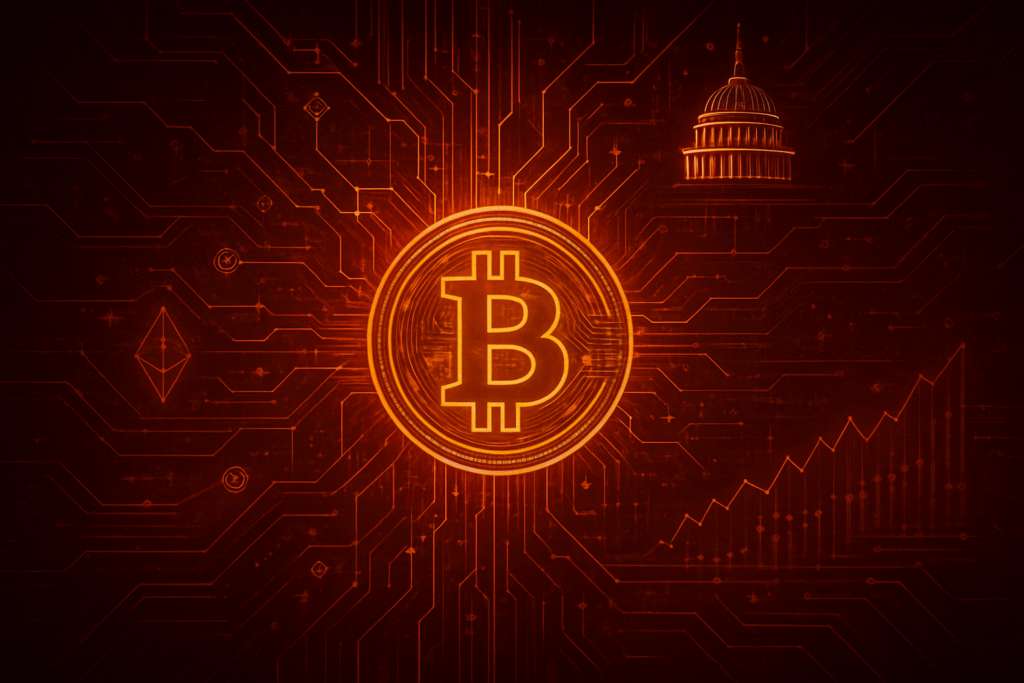
The U.S. Government has dramatically solidified its position as the world's largest sovereign holder of Bitcoin and other cryptocurrencies, a development primarily driven by a series of unprecedented asset seizures and a significant pivot in federal policy throughout 2025. This culminated in a colossal seizure of approximately 127,271 BTC in October 2025, linked to a sophisticated "pig-butchering" scam, which propelled the government's total Bitcoin reserves to over 325,000 BTC, valued in the tens of billions of dollars. This monumental accumulation, largely from illicit activities, has sent shockwaves through the crypto market, raising immediate concerns about stability, potential price volatility, and the long-term implications of such a powerful new market actor.
This strategic shift, formalized by President Trump's executive orders in March 2025 establishing a "Strategic Bitcoin Reserve" and a "U.S. Digital Asset Stockpile," marks a departure from passive custodianship to active strategic management of digital assets. The immediate market reaction has been a mix of apprehension over potential government sell-offs and cautious optimism regarding the newfound legitimacy and regulatory clarity these actions might bring. For the crypto ecosystem, this matters profoundly: it elevates digital assets to the level of national strategic reserves, introduces a powerful, policy-driven market influencer, and signals a maturing, albeit complex, regulatory landscape that could fundamentally reshape the future of decentralized finance and Web3.
Market Impact and Price Action
The news of the U.S. Government's burgeoning crypto holdings, particularly the record-breaking October 2025 Bitcoin seizure, initially injected a degree of uncertainty into the market. While specific real-time data for price movements immediately following the October 2025 event are still being fully analyzed, historical patterns suggest that such large-scale announcements often lead to short-term volatility. Investors frequently react to the prospect of a massive supply of seized tokens potentially being offloaded onto exchanges, which could theoretically depress prices.
However, the cryptocurrency market, especially for Bitcoin, has demonstrated increasing maturity and liquidity over recent years. Past significant government seizures, such as those related to the Silk Road dark web marketplace or the 2016 Bitfinex hack, have shown that while initial jitters may occur, the long-term market impact is often contained. The U.S. government has historically managed the sale of seized assets through controlled auctions or in tranches, strategies designed to minimize disruption. This approach suggests that while the sheer volume of the government's current holdings is unprecedented, any future liquidation efforts would likely be executed with market stability in mind.
Trading volumes might see an uptick around such announcements, reflecting both selling pressure from fearful investors and buying interest from those who view temporary dips as opportunities. Overall, while the U.S. Government's new status as a top holder introduces a powerful, non-market-driven force, the market's resilience and the government's cautious approach to asset disposition are likely to mitigate extreme or prolonged negative price action. The broader macroeconomic environment, including the ongoing U.S. government shutdown in early November 2025, is currently a more immediate driver of liquidity and investor sentiment, with its resolution anticipated to be a bullish catalyst for risk assets, including crypto.
Community and Ecosystem Response
The crypto community, spanning social media platforms like Crypto Twitter and Reddit, has responded with a complex mix of cautious optimism and underlying concerns regarding the U.S. Government's escalating crypto holdings and evolving policy stance in 2025. While law enforcement's success in dismantling illicit operations, such as the "pig-butchering" scam leading to the October 2025 seizure, is generally applauded, the sheer scale of the government's accumulation sparks debate. Many question the long-term implications for global Bitcoin liquidity and market dynamics, with discussions often revolving around the balance between combating crime and potential governmental overreach, particularly if asset seizure powers are expanded without robust due process protections.
Reactions from crypto influencers and thought leaders reflect this duality. Figures like Jameson Lopp and Samson Mow express bullish sentiment, anticipating an era of nation-state Bitcoin adoption and strategic reserves, viewing the U.S. government's legitimization of Bitcoin as a significant step towards mainstream acceptance. However, privacy advocates and some policy experts voice concerns that expanding seizure capabilities could undermine core crypto principles of transparency and decentralization. The establishment of a "Strategic Bitcoin Reserve" has also generated mixed reactions, with some prioritizing victim reimbursement over government stockpiling, while others remain cynical about government motives, drawing parallels to civil asset forfeiture practices.
The policy shifts throughout 2025, including the "Guiding and Establishing National Innovation for U.S. Stablecoins" (GENIUS) Act in July 2025 and the rescission of Staff Accounting Bulletin 121 (SAB 121), have been largely welcomed. These moves, aimed at providing regulatory clarity and fostering innovation, are seen as beneficial for DeFi protocols, NFT projects, and broader Web3 applications. The explicit rejection of a U.S. Central Bank Digital Currency (CBDC) has also been met with approval, signaling a preference for private-sector innovation. However, ongoing macroeconomic factors, such as the U.S. government shutdown in October-November 2025, demonstrated the market's sensitivity to broader liquidity shifts, temporarily overshadowing some of the positive policy developments and delaying the finalization of crucial market structure legislation.
What's Next for Crypto
The period following November 7, 2025, is poised for significant developments in the crypto market, largely influenced by the U.S. Government's role as a major crypto holder and its increasingly pro-innovation regulatory stance. In the short term, the immediate catalyst to watch is the resolution of the ongoing U.S. government shutdown. Its conclusion is widely expected to be bullish for crypto markets, potentially releasing pent-up liquidity and restoring investor confidence. Furthermore, the continued implementation of the GENIUS Act for stablecoins and the work of the SEC's "Crypto Task Force" will provide ongoing regulatory clarity, reducing perceived risks for institutional investors and accelerating mainstream adoption.
Long-term implications are even more profound. The establishment of the Strategic Bitcoin Reserve elevates Bitcoin to a strategic asset class, akin to gold, which could inspire other nations to follow suit, creating a new layer of global demand and further institutionalizing crypto in national finance. The U.S. aims to develop a comprehensive regulatory framework, with legislation like the "Digital Asset Market Clarity Act" (CLARITY Act) expected to define when a digital asset is a security or a commodity, thereby providing much-needed jurisdictional clarity for the entire market. This robust framework, coupled with the explicit rejection of a U.S. CBDC, positions the U.S. to become a global leader in digital finance, fostering innovation in DeFi, Web3, and other blockchain applications.
For projects and investors, strategic considerations include prioritizing compliance with emerging federal frameworks, particularly for stablecoins, and focusing on robust governance and security measures to attract institutional interest. Monitoring policy signals—such as executive orders, Treasury hearings, and SEC statements—will be crucial, as these can serve as real-time catalysts for market movements. While the overall outlook leans bullish, the market will remain susceptible to macroeconomic factors and geopolitical events. The most likely scenario is the U.S. solidifying its role as a dominant crypto hub, driven by clear regulations and strategic government holdings, potentially pushing Bitcoin prices significantly higher. However, gradual progress with challenges due to legislative delays or unforeseen macroeconomic headwinds remains a medium-likelihood scenario, while a significant regulatory backlash is considered a low-likelihood outcome given the current political momentum.
Bottom Line
The U.S. Government's ascension as the world's largest Bitcoin holder marks a pivotal moment for the cryptocurrency ecosystem. For crypto investors and enthusiasts, the key takeaway is the dual nature of this development: while the sheer volume of government-held assets introduces a new, powerful market dynamic, the accompanying shift towards clearer, more innovation-friendly regulatory policies is likely to bring long-term legitimacy and institutional adoption. The establishment of a "Strategic Bitcoin Reserve" signals a profound change in how sovereign nations view digital assets, treating them as strategic national resources rather than merely speculative instruments.
The long-term significance of this trend cannot be overstated. It sets a precedent for other nations, potentially leading to a global race for digital asset accumulation and integration into national financial strategies. This, combined with the U.S. government's commitment to avoiding a CBDC and fostering private-sector innovation, positions the nation to lead the global Web3 revolution. However, vigilance remains crucial. Investors should monitor important dates and metrics, including the resolution of the U.S. government shutdown, progress on key legislative bills like the CLARITY Act, and any further guidance or rulemaking from regulatory bodies like the SEC and CFTC.
Ultimately, the U.S. Government's deep involvement, both as a holder and a regulator, is a double-edged sword: it brings unprecedented validation and potential for growth, but also introduces a powerful, centralized entity into a historically decentralized space. Navigating this evolving landscape will require astute observation of policy, market sentiment, and technological advancements, as the implications for crypto adoption, innovation, and global financial sovereignty continue to unfold.
This article is for informational purposes only and does not constitute financial or investment advice. Cryptocurrency investments carry significant risk.





